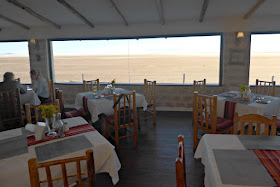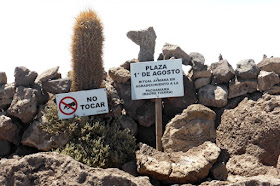 |
| It doesn't look promising, but wait ... |
We dined in a small village, San Juan.
Samuel had arranged a feast at the hostel/community-center.
 |
| Wonderfully decorated. |
Continuing on, we soon left the road system and were either driving in or avoiding previous vehicles' ruts, as Samuel preferred. There was a small business where the route crossed a paved road.
 |
| A 500 Bs. fine for taking a pit stop among the rocks. Click to check out the sign. |
A closer look.
We continued cross-country, stopping once for tinamou. Carlos and Joan had spotted a tinamou much earlier in the trip, but this was my first glimpse.
This sparse country can support herds of vicuña. Click on the image to enlarge.
Then spread out before us was the Lagoon Cañapa, host to three different species of flamingo, including the rare James's flamingo, which inhabits only the high Andean plateaus. It was thought extinct until it was rediscovered in 1956!
A closer look at the James's; identifiying marks are brick-red legs and black-tipped yellow bills.
There's a juvenile, merely black-and-white, in this group. It takes one two to three years to "pink up" from its diet.
Zooming in on the youngster ...
Flamingos often provide amusing photos.
Flamingos in flight way above sea level.
The wind was howling across the lagoon. The air may be thin, but kinetic energy increases with the square of the velocity. Afterwards, departing the lagoon, Joan and I posed again.
 |
| I'm glad my face is in the shade. The expression is not charming! |
The braiding created by the vehicles, whose drivers hate to ride in others' tracks, grew astonishingly severe. We're told that the drivers resist adding a formal road in such places, because that might encourage tourists to drive themselves. I think there are major obstacles to self-tourism in this part of country, including a lack of refueling stations and the ability of the government to require a Bolivian guide accompanying.
But there were brave self-propelled souls out here: we passed a duo of bicyclists setting up camp, out "in the middle of nowhere" at 15,000 feet. That's more of a challenge than my legs or my lungs would want to take on.
We arrived at the Tayka del Desierto, an off-the-grid hotel that is part of the Bolivian Tayka group, but in part owned by a local community association.
This facility provides income to the association and training and jobs for the inhabitants of this region of the Siloli desert. Power is supplied by wind turbines and solar panels. There is sufficient hot water, as long as you aren't profligate, and enough electricity to recharge batteries, but not to run hair dryers.
We checked in and cleaned up and went to dinner, which was a huge surprise. This meal was clearly intended as a first-class training ground for the kitchen and staff. The servers were dressed crisply with white shirts and black vests, the fixed menu was excellent, and the place settings white-tablecloth. Every table had a wonderful view of the desert and mountains outside. We noticed that much of the chatter in the dining room was in French; Europeans make up a large portion of the overseas tourists in Bolivia.
After dinner I resolved to try some nighttime photography of the stars here at 15,000 feet. The air had cooled rapidly with the setting of the sun, and the panoply of stars was bright. I wanted to combine the "night sky" setting with the "delay start" setting on my point-and-shoot, so that I could set the camera on the ground facing up. But I kept having trouble with it. Nonsense or pictures of my chilled fingers were all that I could capture. Then I tried several hand-held shots towards the hotel and sky with different fixed exposure times, and I was able to hold the camera steady enough for one recognizable photo. You can see some of the brighter stars. (I have lightened the image using the GIMP just to the edge of having too much noise.) Click on the image to enlarge and see the stars.
I did not linger any longer in the cold, and soon it was time for bed at our highest overnight altitude. Joan had been taking gingko biloba earlier in the trip as a preventive measure for altitude discomfort, but it hadn't helped, so this morning she had taken prescription Diamox instead. Technically Diamox should be started a few days before reaching high altitude, but in just one day she felt much better.
I thought I was doing OK on my own; however, twice during this night I awoke feeling short of breath. Huffing and puffing to pull in oxygen relieved the feeling and let me go back to sleep, and I never had a headache, but if there's a next time going this high I'm ready to try Diamox.
In the morning, after a basic but filling breakfast buffet, Samuel, Carlos, Joan and I prepared to depart for the adventures of our last day in Bolivia.
 |
| Fuel canisters strapped to the top of the vehicle. |
Saddle up!

























































